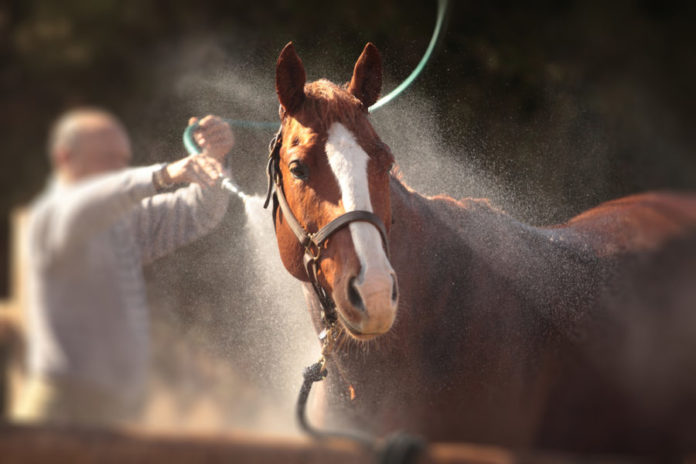
Equine Wellness Magazine By Karen Scholl
Does your horse hate being bathed? Here’s how to approach bath time a little differently to make it a positive experience for everyone.
Many horses seem to turn into different animals at bath time. From the gentle horse anyone can ride to the stunning equine athlete that takes home all the ribbons, their bath time behavior can range from mild anxiety to thrashing panic!
After witnessing every kind of bathing behavior and the varied techniques used to deal with it, I believe it’s important to understand how horses think and what motivates them if we hope to help them become more confident and relaxed in the wash area.
From your horse’s perspective
Let’s first consider a bath from the viewpoint of a horse in his natural environment. Being prey animals, horses live in herds on open grazing areas, so the only time water pours over them is during a rainstorm. Horses turn their hindquarters toward the wind, tuck their tails and lower their heads to wait out the heaviest part of the storm. After the rain lets up, it’s common to see horses rolling in the dirt or mud. It’s important to know that dirt naturally protects the skin of many animals from sun and insects. Horses prefer to be dirty while we prefer them to be clean; understanding their preference for dirt and their lack of enthusiasm for bathing can perhaps help us keep a bit of our sanity!
So how might we change the mind of a horse to tolerate or even enjoy bath time? The simple answer is to think of ways to make it a positive experience, similar to tossing bath toys in the tub for young children!
Make a good first impression
The easiest scenario, believe it or not, is with a horse that’s never had a bath. Maybe it’s a young horse or one that’s been brought up in a ranching or pasture environment. This horse has no opinion about bathing, so introducing the activity in a polite, positive way will form a first impression that will last a lifetime. But don’t worry — the horse that has made of career of hating baths can be turned around using the same approach. It may just require more time to change his mind.
If possible, introduce bathing on a really warm day! It makes sense that the cool water will be a welcome relief to the horse. Begin by not tying the horse, as prey animals naturally perceive a greater threat when movement is confined. Use a halter and lead so you can apply some “drag” to discourage movement while still allowing the horse to “drift” and move as he gets used to things.
As I say in every course I teach — the bad news about horses is that they’re afraid of anything new, different, sudden or abrupt. The good news is that they very quickly become familiar and comfortable with anything new, different, sudden or abrupt if there is no pain — physical or mental — associated with it.
7 steps to bath time confidence
1. Begin in a large area with a decent length of hose with a nozzle that can be controlled both in terms of on/off and firmness of water pressure. With the water off, detach the nozzle and introduce it to your horse by rubbing it on his shoulder, and then allowing him to briefly smell it. This is how I like to introduce new items to horses; the shoulder seems to be the least threatened part of the body and with a little bit of their scent on the item, there’s an instant familiarity. It’s one of those little things that seems as if it wouldn’t matter much, but it can make introducing new things go faster, and it only takes a minute!
If the horse moves away, put a little “drag” on the lead rope, releasing all pressure the instant he stands still, and then take the object away as a “reward” for the behavior of standing still. The point of this approach is to teach the horse that standing still and relaxing is a rewarded behavior and that you’ll allow him the time he needs to become familiar with the object.
If this seems like a slow, ridiculous and unnecessary approach, just know that the ultimate objective is to gain the trust of this prey animal to a point that this process will take only moments in the future.
2. When your horse is relaxed with the hose nozzle, attach it to the hose with no water pressure and again give the horse a moment to relax, putting drag on the lead if/when he moves, and zero pressure when his feet stop. Don’t worry about getting his feet back where they started, as it’s not necessary to this part of the process.
3. Turn on the water pressure to mid-level and begin to spray the ground. This is when the lead line and hose can get a bit in the way as the horse drifts; be ready to step over the line/hose as the horse “drifts” with “drag” on the lead, turning off the nozzle immediatelywhen his feet stop moving. Give your horse a moment to stand, relax, and realize that only his movement caused pressure on the halter and that standing still caused release from that pressure. Watch for signs of relaxation and understanding: blinking eyes, lowered head, licking or chewing, and ear waggling.
4. As your horse begins to recognize that moving = pressure, and standing = release/reward, you can advance in proximity and pressure with the water. As you wave the soft shower of water closer to his feet, then away, then back again, eventually allowing water to touch his feet and lower legs, always remove the water and give the horse a moment to realize there was no pain associated with this unfamiliar or disliked activity.
5. Remember that water droplets can feel “tickly” to a horse and can cause him to move or even kick at his belly, so use your hand, a sweat scraper, or more water spray to help stop the “tickles”! As the horse gains more confidence and trust, you’ll more than likely find him beginning to actually enjoy the water and the sensation of a higher intensity spray.
6. When your horse is confident and relaxed while untied, go through this routine again at the wash rack (being untied at first) until he gains more confidence in the new location with his movement limited.
7. Feel free to use your imagination to adapt this approach to what’s available to you for your horse’s comfort — having a buddy horse that likes baths nearby, tying a “sweet-lick” treat to the wash rack for your horse to enjoy, or making the wash rack the feeding place or a resting spot after exercise, etc.
Important safety notes
- As with all behavior-shaping techniques, safety is the highest priority! I cannot emphasize this enough – having a dirty horse is way better than having any kind of injury, so if you don’t feel confident at any time when attempting the approach described in this article, please hire a professional who understands this approach and can help you.
- Do not put yourself in danger by getting tangled up in lead lines and hoses. You do not need to continue just because your horse hasn’t stopped moving yet. Chances are that if the horse is moving so much that you’ve become tangled up, he could use a break while you get your lines sorted out again.
- If your horse has issues with standing tied, that’s a different subject altogether! Do not expect him to be okay with being bathed if he is not confident about standing tied for a period of time.
Because every horse is unique, there are no rules when attempting to shape their behavior; just go with what you find to be effective or ineffective. And who says you can’t take your horse to a favorite spot to roll in the dirt and then rinse him off again? As we’ve all heard many times before, a little dirt never hurt!



